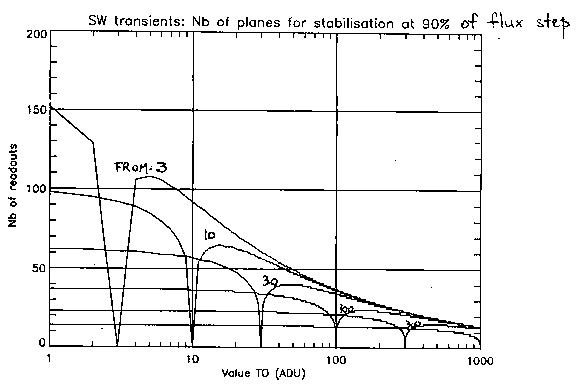
Figure: Flux step dependence of
 for the SW array
for the SW array



 : assuming
that the average signal of the array was stabilized at a level FROM
= 10 ADUs. We take the curve for which the peak down to the TO
axis is at the abscissa 10 ADUs. Assuming the following
observation is expected to give an average stabilized signal TO = 3
ADUs, we read
: assuming
that the average signal of the array was stabilized at a level FROM
= 10 ADUs. We take the curve for which the peak down to the TO
axis is at the abscissa 10 ADUs. Assuming the following
observation is expected to give an average stabilized signal TO = 3
ADUs, we read  = 90 as the ordinate of the curve at
TO = 3 ADUs. Now, if TO = 100 ADUs,
= 90 as the ordinate of the curve at
TO = 3 ADUs. Now, if TO = 100 ADUs,  = 45. Of
course, if FROM = TO,
= 45. Of
course, if FROM = TO,  = 0, which is the point on the
TO axis.
= 0, which is the point on the
TO axis.

Figure: Flux step dependence of  for the SW array
for the SW array
On the lower panels of Figures  , it can be seen
that after
, it can be seen
that after  readouts the image in some cases is still
somewhat distorted.
readouts the image in some cases is still
somewhat distorted.
In the SW channel wavelength range, the IR background is very low,
and the situation which will be encountered during all the
observations of faint sources is indeed the worst case, with the
sensitivity limited by the stabilization time, and not by the noise.
To overcome this problem, we have tested several observing
procedures. The best results were obtained by a pre-flash of the array
done with the internal calibration device at the beginning of the
observations. The astronomical sources are observed during the
slow decay of the array after the pre-flash. In a second step, we
reproduce the same flash and slow decay, while the entrance wheel
of the camera is closed. Subtraction of the reference decay permits
to reveal the faint sources. The pre-flashing procedure reproduces the
flash with a few percent accuracy and allows to detect sources in
the mJy range, in 20 minutes observing time, while a normal
observation would have required several hours due to the slow
stabilization. In this observing mode, we can recover the readout
noise limited sensitivity, which is of few tenths of mJy in 1 hour.
This FLASH-MODE procedure is described in detail in section
 .
.



